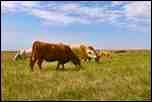Do you know the four Rs of summer grazing? Do you incorporate them into your summer grazing plans? If you follow the four Rs summer productivity on pasture can be increased, more fall grazing days can be achieved, and livestock will have better gains over the grazing season.
The first "R" refers to 'removal of the seed heads'. Sounds pretty easy; simply put, this means putting livestock out to clip the seed heads off of actively growing grass plants. As seed heads are removed grasses return to their vegetative state and growth continues. In addition, forage in the vegetative state is of higher quality than more mature forage.
The second "R" is 'right starting height'; this is a bit trickier to manage. Livestock should not be put out to pasture when/where grass is short - ultimately this leads to overgrazing. With the late and cool spring this year it was hard to wait for pastures to get to the right starting height before turning animals out. Some producers may be short grazing days in the fall if they turned livestock out too early this spring. The right height depends on the forage species you're grazing. Contact your local Regional Forage Specialist for more information.
The third "R" refers to 'residual leaf area', or amount of leaf/plant material left after grazing has occurred. The more leaf area available, the more photosynthesis can occur, and subsequently growth can continue after grazing. Most of us have heard of the "take half, leave half" rule - that's what the third "R" is in reference to. Allow the animals to graze half the plant, leaving the remaining half intact. Taking more than half of the plant puts severe pressure on the root system and it will take longer for the plant to recover and become usable once again.
The fourth "R" is sometimes the hardest to manage, 'rest period'. After a stint of grazing we must allow enough time to pass, such that the plants in the paddock have time to recover and regain that 'lost height' or put back that 'leaf area'. Rest period is affected by how much residual leaf area there is; the air and soil temperature and soil moisture. Earlier in the season plants are growing and recovering quickly, air and soil temperatures are cooler and moisture is typically higher, therefore rest periods can be shorter; some refer to this as the 'fast growth, fast moves' stage of grazing. As the days get longer and plants begin to mature, air and soil temperatures are warmer and often soil moisture suffers, slowing plant growth. During late summer slow growth means slow moves and longer rest periods are required for plants to recover. The best way to maintain longer rest periods in the late summer grazing period is to have enough paddocks that you can move animals around and give previously used sections the time they need to recover from the latest grazing.
Following good management practices like the four R's of summer grazing can help reduce negative impacts of weather related challenges such as periods of low rainfall or in severe cases, drought.
For more information on this or other livestock related topics, please contact Jenifer Heyden, at 306 446-7961 or the Agriculture Knowledge Centre at 1-866-457-2377.
- Heyden is Regional Livestock Specialist, North Battleford Regional Services Branch




